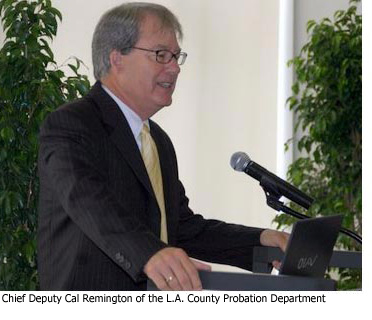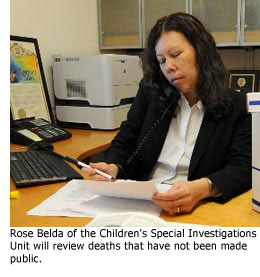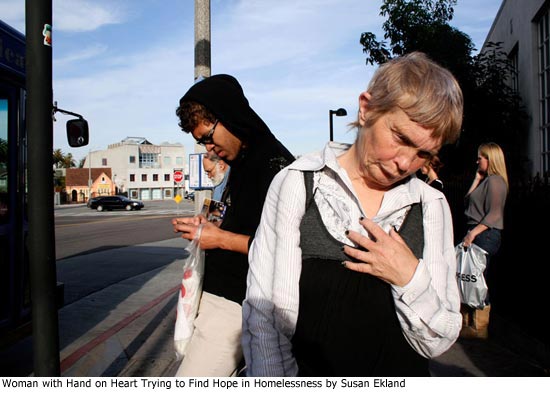Secret child-death records to be revealed
August 31, 2010
Los Angeles County’s top child welfare official—confronted with contradictions in her agency’s own records—vowed Tuesday to make public the deaths of dozens of children who’d been abused or neglected but whose cases had been questionably kept secret.
That pledge from Trish Ploehn, director of the Department of Children and Family Services, came on the heels of an independent study that raised new concerns about the agency’s compliance with a 2008 state law requiring the disclosure of child deaths that result from abuse or neglect.
The report, written by the county’s Office of Independent Review, said DCFS’ actions had effectively “frustrated” the law’s goal of preventing future tragedies by enhancing public scrutiny and promoting a more informed debate from which sound policy can flow.
For a third straight week, the issue of public access to child-death documents dominated the Board of Supervisors meeting—this time with less rancor but with a slew of new questions that have turned up the heat on Ploehn, who has spent the better part of a year defending her department and its stewardship.
On Tuesday, during her testimony before the board, Ploehn managed to diffuse some of the latest criticism by quickly making it clear that she agreed “100 percent” with at least one of the more troubling findings in the Office of Independent Review report.
The report disclosed that DCFS, in confidential dependency court documents, had classified upwards of 60 child deaths as resulting directly from neglect and abuse. But when it came to complying with a state law known as SB 39, DCFS exempted many, if not all, of those cases from public disclosure by concluding that they were not directly caused by abuse or neglect.
Ploehn blamed a lack of communication—and a difference in missions—between the two branches of her office responsible for the conflicting findings.
The dependency court filings, she said, relied on a broadly worded statute used to immediately remove at-risk siblings from homes where children had died and where there’d been evidence of abuse or neglect. The SB 39 cases, she said, required a much narrower finding that the death of a child was caused specifically by abuse or neglect.
“There was no communication or consultation going on between these two entities,” Ploehn told the board. “Therefore, we were in parallel universes.” She said every case in which DCFS had invoked the most serious claims of abuse or neglect in court filings would now be reclassified as a public document under SB 39 “and we will release those records.”
Michael Gennaco, who heads the Office of Independent Review, said he found no evidence of a concerted effort by DCFS to conceal child death cases. During the review, the OIR “received no information to believe that this alleged inconsistent approach in assessing child fatalities between different components of DCFS was either intentional or designed,” Gennaco wrote in his report and repeated during his Tuesday testimony before the board.
That statement, however, brought a quick word of caution from Supervisor Zev Yaroslavsky.
“I don’t think you have all the information that you’re going to have going forward,” Yaroslavsky warned Gennaco, adding: “There are reasons to believe this is not just an accidental disconnect, [that] the left hand didn’t know what the right hand was doing.”
Last week, Yaroslavsky raised the possibility that DCFS may be failing to comply with the public disclosure requirements of SB 39 to shield itself from criticism. Specifically, he pointed to the case of an 11-year-old boy who had hung himself in June after years of physical abuse. That case, Yaroslavsky said, had not been publicly disclosed, even though the boy’s suicide seemed to be the direct result of the abuse he suffered.
On Tuesday, under questioning from Yaroslavsky, Gennaco acknowledged that the boy’s death was one of the anonymous examples in his report, one in which DCFS had cited abuse as the cause of death in court documents but made no similar finding under SB 39.
“The issue for me is whether…the public is getting complete and accurate information about child deaths, which was the purpose behind SB 39 in the first place in 2008,” said Yaroslavsky, who praised a series of recommendations Gennaco offered to bring more clarity and continuity to DCFS’ procedures. “I raised it last week and I was right.”
In his report, Gennaco said that DCFS’ public disclosure of child-death cases also had dropped dramatically in the past two years because of “blanket law enforcement objections to the release of information.” He blamed this on DCFS’ failure to give law enforcement officials copies of the files to determine what information might—or might not—jeopardize an ongoing criminal case. In the absence of such details, Gennaco said, it’s understandable that law enforcement agencies would opt to keep the entire case confidential.
“It is apparent that that the stream of information about SB 39 child deaths that was flowing in 2008, has been largely shut down two years later as a result of law enforcement’s blanket holds,” Gennaco wrote.
So many Los Angeles County cases are being excluded from public disclosure in this way under SB 39, Gennaco said, that there’s “a virtual paralysis of the statute’s intent.”
He suggested that DCFS immediately begin providing more information to law enforcement agencies before decisions are made about public disclosure and that continuous reviews are made of case files to determine when additional information can be released.
Overall, Gennaco concluded, DCFS must develop a mindset and procedures that recognize the intent of the state law is to provide more, rather than less, information to the public and thus “ensure that there is a consistent and principled determination of what constitutes SB 39 cases subject to disclosure.”
Posted 8/31/10
Golden voice, golden man
August 26, 2010
For our Boys of Summer—the fading L.A. Dodgers—it’s almost time to sadly invoke that old bromide, “Wait ‘till next year.” But for our Voice of Summer—the incomparable Vin Scully—that saying is cause for celebration. Scully has announced he’s returning for another year, his 62nd with the Dodgers, dating back to the Brooklyn days.
For me, and millions of you, his voice has been an uplifting summer soundtrack for decades—musical in its rhythm and lyrics.
In junior high, I remember carving out the pages of one of my dad’s books (a prized book, it turns out) so I could hide a transistor radio and listen in class to Scully call the ’63 World Series. Of course, I got caught—with no regrets.
Years later, as a new UCLA grad, I wrote to Dodgers owner Walter O’Malley offering my services in the booth alongside Vin. Mr. O’Malley wrote back saying thanks, but that the broadcast team was in good shape.
Then, in my early 50s, I had the honor of interviewing Scully on radio station KPCC for 30 minutes. I’d ask a question and off he’d go—eloquent, funny, profound.
Yes, here in Los Angeles we’re facing serious social and economic problems. But it’s good to know that, like in so many years past, one transcendent man will be there to provide comforting continuity amid the changes and challenges.
Posted 8/26/10
New bill would broaden child welfare database
August 26, 2010
 Los Angeles County child-welfare officials won an important victory in Sacramento this week in the quest to help social workers better investigate allegations of child abuse.
Los Angeles County child-welfare officials won an important victory in Sacramento this week in the quest to help social workers better investigate allegations of child abuse.
Passed unanimously in the Assembly and Senate, Assembly Bill 2322 expands information available to county social workers in a computer database called the Family and Children’s Index (FCI), which provides child welfare workers with key medical, law enforcement and social services data as they launch child welfare investigations.
The new legislation would allow Los Angeles County to include in FCI convictions for crimes against children by family members and others living with a child who has come to the attention of child welfare authorities.
“This will provide key information for social workers who often have to make split second decisions about how best to protect a child,” said Dawyn Harrison, a principal deputy county counsel working on FCI issues.
Under the old system, social workers had to wait days or weeks to obtain information about convictions of family members and could learn nothing about convictions of non-family members. Speed is crucial when Department of Children and Family Services emergency workers use FCI as they launch investigations into reports of alleged abuse or neglect.
The bill, sponsored by Assemblyman Mike Feuer and former speaker Karen Bass, is awaiting the signature of Gov. Arnold Schwarzenegger.
“We have indications that he is going to sign it,” said Ryan Alsop, the county’s assistant Chief Executive Officer for intergovernmental and external affairs.
The new law would take effect immediately.
Posted 8/26/10
Orange Line Extension briefing in Canoga Park
August 26, 2010
Metro Orange Line Project staff will host a community briefing and construction update on September 2, 2010 at 6:00 p.m. at the community room at the Los Angeles Police Department’s Topanga Community Police Station, located at 21501 Schoenborn Street in Canoga Park.
When the new section is completed in 2012, the Orange Line Extension will stretch four miles, from Warner Center north to Chatsworth.
The public is encouraged to register and be a part of the electronic distribution list to be kept informed of construction activities. Send Community Relations a note with your name and email address at [email protected] or call them on the Project Hotline at 213-922-3668.
Posted 8/26/10
L.A. County property values take deep slide
August 26, 2010
 Total property values in Los Angeles County sunk last year by the sharpest margin since 1995, during the depths of the last housing recession.
Total property values in Los Angeles County sunk last year by the sharpest margin since 1995, during the depths of the last housing recession.
The property rolls in the county fell $18.5 billion, to a total of $1.089 trillion—a 1.7 percent decline from 2009.
The valuations are disclosed in the L.A. County Assessor’s newly-released 2010 Annual Report. The yearly snapshot of 2.3 million residential and commercial properties details changes in value in all of the county’s 88 cities and unincorporated areas, providing residents with a guide to property trends in their communities.
Assessor Robert Quon attributed the drop chiefly to the housing malaise.
“The largest factor was the continuing decline in home values,” said Quon, who was appointed as assessor on April 1, after 39 years in the department, to replace the retiring Rick Auerbach. Quon is not running for the post in the November election.
But also contributing to this year’s decline was a rare occurrence: no inflation.
In previous years, rising inflation has meant higher valuations, which are allowed under Proposition 13, so long as they don’t exceed 2 percent. This year, inflation actually fell by .3 percent, Quon said. The result: $2 billion less on the assessment rolls. “This is the first year that [the inflation factor] has been negative,” Quon said.
In preparing this year’s report, Quon said his office focused on areas hit hard by the housing bubble-and-bust, reviewing the values of 583,000 homes and condominiums, most of which were purchased between 2003 and 2009,
Of those, about 400,000 had declined in value. The average single family home plunged by $162,000, while condos fell by $133,000. The good news was that the lowered assessments brought a reduction in property tax bills for those condo and home owners of between $1,500 and $1,800, respectively.
The outlook for local government, however, is not so good.
The reduced revenues in cities that saw values decline will mean a drop in funding for schools and public services that depend on property taxes, Quon said.
“If there is a reduction in value that is warranted, we go out and reduce those values, regardless of what it means for government revenue,” Quon said. “We are trying to be accurate” to be certain no property owners aren’t charged more than their fair tax burden.
Overall, property values fell in 61 of the county’s 88 cities and in unincorporated county areas. Los Angeles fell 2.3 percent; Long Beach slumped 2.9 percent; Beverly Hills lost 2.6 percent and Santa Monica edged down 0.9 percent.
The steepest declines were in the Antelope Valley; Palmdale fell by 12 percent, while assessed values in Lancaster shrank by 14.4 percent
The unincorporated areas, listed in a single category and not broken down by location, saw a 2.6 percent decline.
Meanwhile, values rose or held steady in 27 cities. In addition to county-leading Arcadia (up 4.4 percent), Hidden Hills rose 2.0 percent, Glendale rose 1.3 percent and Malibu climbed 1.2 percent.
Despite the drops, Quon says the county’s property tax base remains “strong.” It’s the third highest total on record—topped only by 2008 and 2009. He said the county hasn’t suffered as much as neighboring counties that have been hit even harder by the housing crunch.
Also, in another bit of encouraging news, Quon said property foreclosures in Los Angeles County in 2009 dropped to 36,500 from 41,300 in 2008.
Posted 8/26/10
Who’s making what?
August 26, 2010
 Starting this week, the salaries of roughly three dozen Los Angeles County executives who head agencies as obscure as the office of Military and Veterans Affairs and as massive as the Department of Public Social Services can be viewed online for the first time.
Starting this week, the salaries of roughly three dozen Los Angeles County executives who head agencies as obscure as the office of Military and Veterans Affairs and as massive as the Department of Public Social Services can be viewed online for the first time.
The action came after the Board of Supervisors two weeks ago unanimously approved a motion by Supervisor Zev Yaroslavsky aimed at increasing transparency in the wake of the city of Bell salary scandal. The salaries of the county’s elected officials have long been a matter of public record, as have salary ranges for all job classifications within the bureaucracy. (Members of the Board of Supervisors make $178,789 a year.)
Topping the newly posted list of board-appointed officials is Chief Executive Officer William T Fujioka, with an annual salary of $338,458. He’s followed by the director of the Department of Public Health, Dr. Jonathan Fielding, whose annual salary is $309.494.
The complete list can be seen here and accessed through county’s main website.
Posted 8/25/10
Picturing a homeless woman’s world
August 25, 2010
It’s been nearly 18 months since nine homeless women picked up cameras and set out to tell the stories of their world.
From Santa Monica to Skid Row, the women captured striking images: A street-weathered face against a backdrop of palm trees. Haunting yet hopeful interiors decorated with stuffed toys. A Ferris wheel turning under a blue sky as a hand grips a cigarette in the foreground.
The project, under the auspices of Venice Arts in collaboration with the Ocean Park Community Center, came to be called “Got Caught Up Out There.” (See gallery of selected photographs below.)
For some of the women, the experience was transformative. Two have enrolled in Santa Monica College. Among the others, there’s been a reunion with a long-lost friend, a volunteer job, a relocation to Hawaii.
One of the college students, Althea Anderson, is pursuing a career in photojournalism. The other, Rita Elzy, aspires to a master’s degree in fine arts. “My vision is to work with the special needs population,” says Elzy, 57, who at one time was sleeping in a car in Beverly Hills.
“It was fabulous,” she says of the experience. “We were working with professional people. The equipment we used was state of the art. It was just a great way to tell a story.”
Like Elzy, all but two of the women are now in apartments or other housing and receiving services.
Even those who’ve drifted away took something meaningful from the 10-week photo workshop, says Amy Turk, project director of OPCC’S Daybreak program for homeless women with long-term mental illness. “I think it was maybe one of the most professional opportunities they had had for a while.”
Photojournalist Jim Hubbard, creative director at Venice Arts, ran the program with photographers Giselle Macfarlane and Maya Myers. The project received funding from the county Arts Commission.
Hubbard called the participants “an incredible group of women” who brought depth and humor to their work. “Instead of being depressing,” he says, “this was one of the most entertaining projects I’ve ever worked on.”
The women’s photos, which can be viewed online, have been featured at the Venice Arts Gallery and the Sam Francis Gallery at Crossroads School. They also were showcased in a limited edition book that includes quotes from some of the women, including Althea Anderson, who says: “I feel like I got my self-esteem back.”
Posted 8/25/10
The photographers
Report says Probation rife with problems
August 25, 2010
 In a searing critique, a top official of Los Angeles County’s Probation Department says the agency has been plagued by weak management, poor communication, entrenched perceptions of favoritism and staffers who would never have survived a rigorous background check.
In a searing critique, a top official of Los Angeles County’s Probation Department says the agency has been plagued by weak management, poor communication, entrenched perceptions of favoritism and staffers who would never have survived a rigorous background check.
“It appears that problems were ignored continuously and defective operations were allowed to ‘muddle by’ with little emphasis placed on getting back to the basics to become a high functioning organization,” Remington wrote.
Five months in the making, the report by the department’s current chief deputy, Cal Remington, provides a study in organizational dysfunction across multiple fronts, particularly in the Administrative Services Bureau, which he says affects every phase of the department. The bureau includes such responsibilities as internal affairs, budget and fiscal services and human resources.
Remington’s 67-page report—called “Back to the Basics: The Steps Required While Moving Forward”—was presented to the Board of Supervisors on Tuesday. It offers 131 recommendations to improve management, increase transparency and accountability, and improve services and staff morale while cutting improprieties and poor performance.
The supervisors mandated the report in March as the 6,100-person department, the nation’s largest, was being rocked by disclosures that, among other things, employees used county credit cards to buy electronics goods, that dozens of employees accused of misconduct escaped discipline because the investigations ran too long and that the department could not fully track $79 million allocated by the Board largely to hire personnel.
In an interview, Remington said the department already has jettisoned ineffective staffers from important middle and upper management positions “and replaced them with people who are competent.”
Remington’s proposed fixes range from sweeping strategic changes, such as developing new programs as alternatives to incarceration, to relatively quick fixes that include launching a department newsletter to boost morale. He said the department should also continue to build on a June report by the watchdog Office of Independent Review, which called for an overhaul of internal discipline.
In his report, Remington said he was surprised by the broad community interest among children’s advocates, parents, service providers and others in improving the department’s operations, only to be rebuffed by the organization. “One individual,” Remington said, “indicated that community groups have been knocking on Probation’s door for years, however, the Department would not let them in.”
That situation, he stressed, must be changed.
“The future focus of this Department clearly needs to be on community-based alternatives to incarceration; more programs focusing on families and programs that prepare juveniles and young adults to become productive citizens of the community,” Remington concluded. “This can best be accomplished by working with community-based organizations.”
Remington, a retired probation chief from Ventura County, was acting head of the department in March when he launched his study, serving until new Chief Probation Officer Donald Blevins arrived in April. He now serves as the department’s chief deputy.
He said there must be more transparency in promotions to end nepotism and cronyism that has led to a widespread “feeling that ‘it isn’t what you know, but who you know’” when it comes to promotions. Remington said managers complained to him that “unqualified candidates are promoted with systemic favoritism, nepotism, and chicanery.”
That same attitude among staffers—a sense of being on the outside—extended to the way information has sometimes been conveyed in the department, Remington said, particularly when it comes to personnel issues. This, he said, has created a workplace where “rumors are prevalent and run rampant.”
He also had some harsh words for “a few” members of the department’s executive team. These individuals were described in interviews as “being rude and having abusive ways in dealing with subordinates.” These top-tier individuals also were described as “being involved with infighting and cliques that have been destructive.”
The report urges that all managers receive mandatory ethics training and calls for the creation of a succession plan that includes a “leadership academy” to groom staffers for promotion.
To improve future hiring, Remington said standards must be raised for background checks. He said that based on his review of disciplinary cases, some employees should have been “screened out at the background phase.” Unlike most departments that hire peace officers, he said, probation does not use a polygraph to screen applicants—a shortcoming he hopes will now be rectified.
He also called for a crackdown on “work-time abuse” by staffers who fail to put in a full 40-hour week for which they’re being paid. In the interview, Remington said the extent of this abuse remains unclear. “It’s a problem we still need to look at,” he said.
The department’s 16 juvenile camps, housing 1,300 clients, were another key target for reform. This area is particularly important because the camps are the subject of an agreement with the U.S. Department of Justice, which is monitoring, among other areas, allegations of child abuse and poor mental health treatment.
Remington said all but three camp directors were interviewed at length and appear, as a group, to be “capable of effectively managing” their responsibilities. The problem, Remington said, is that they’ve “been demoralized as their roles have been shifted from leaders to passive followers.” He said they “feel stripped of the authority to operate their camp or manage their staff” when their decisions are “rescinded without explanation” from higher-ups.
Remington said this problem can be quickly corrected by simply restoring authority to these managers.
To save money and improve services, Remington recommended moving the camps’ reception and assessment units from the Barry J. Nidorf Juvenile Hall in the San Fernando Valley to Challenger Memorial Youth Center, a complex of probation camps in Lancaster.
Despite the deep troubles at Probation, not all of the news is bad, Remington said. Some reforms have already started, and many in the department want to improve. “People here are tired of reading about the ‘dysfunctional or beleaguered Probation Department’ and they want to make a change.”
Posted 8/25/10
New conflict over child death records
August 24, 2010
 For a second consecutive week, the Board of Supervisors tangled over the release of information on the deaths of children who’ve had a history of contact with Los Angeles county child welfare authorities.
For a second consecutive week, the Board of Supervisors tangled over the release of information on the deaths of children who’ve had a history of contact with Los Angeles county child welfare authorities.
The board unanimously approved a motion by Supervisor Gloria Molina asking for an independent analysis of what information the supervisors can—and cannot—make public about child deaths allegedly caused by abuse or neglect. That study will be undertaken by the county’s Office of Independent Review.
Molina’s motion comes one week after Supervisor Zev Yaroslavsky said during a board session that county officials seemed more concerned with plugging leaks than with fixing problems in the Department of Children and Family Services. His comments prompted strong reaction from some of his colleagues and seemed to be a subtext of Molina’s motion on Tuesday.
“All members of this Board support transparency and the County’s duty to disclose information in the public interest—particularly when such information involves the death of vulnerable children,” Molina said in the motion. But she said the board also has a legal duty to protect confidential child information and that the law provides “a clear path” for the disclosure of such data.
“The failure to support ‘leaks’ of sensitive personal and case information outside these legal processes should not be construed as a rejection of transparency,” Molina said in a veiled rebuke to her board colleague, Yaroslavsky.
Yaroslavsky, for his part, pursued a provocative new tack in questioning DCFS’ commitment to transparency. He suggested that the embattled department may intentionally be classifying some child deaths in ways that keep them secret.
Under a California law called SB 39, certain information is made public about a child’s death when it is determined to have resulted from abuse or neglect. Once that determination is made, the public can then seek more detailed information. Without a finding of abuse or neglect, the case remains untraceable.
Yaroslavsky was skeptical of the large number of deaths that DCFS determined were not caused by abuse or neglect in recent years, including the shocking suicide in June of an 11-year-old boy named Jorge T., who’d endured a history of documented physical abuse. Yaroslavsky said DCFS concluded that that death was not the result of abuse or neglect and was not subject to disclosure under SB 39.
“What I’m interested in knowing,” the supervisor said, “is how many other Jorge T.-type cases are there where arguably the death may not have come at the hands of another, but the death was clearly caused by the cumulative abuse and neglect over a period of time. And I think the department has an interest in minimizing the number of cases that they put on the SB 39 list because, frankly, it makes them look better.”
“I think somebody’s making a call on some of these cases that just doesn’t meet the smell test for me,” Yaroslavsky added.
At one point in the discussion, County Counsel Andrea Sheridan Ordin told Yaroslavsky that she believed Jorge’s case was still being investigated and that no determination had been made about whether his suicide was the result of abuse or neglect.
“You believe or you know?” Yaroslavsky asked her.
“I believe,” she responded.
Yaroslavsky’s continued line of questioning prompted this personal barb from Molina: “I know you’re interested in misinforming everyone about what the department [DCFS] is doing or not doing.”
Following the meeting, Yaroslavsky said that “a decision was made many weeks ago not to classify Jorge’s death as an SB 39 case—a determination that has not been changed as of today, more than two months after the youngster’s suicide.”
Prior to Tuesday’s session, Yaroslavsky had hoped to gain support for a motion directing the Children’s Special Investigation Unit (CSIU) to examine whether cases were wrongly excluded from SB 39 disclosure, “thereby preventing a public discussion and the development of policies that could help avert such deaths in the future.” But when it became clear that his colleagues were unwilling to pass the measure, Yaroslavsky said he used his authority to individually ask CSIU to undertake the review.
Rose Belda, who heads the unit, testified Tuesday that based on her experience, the list of SB 39 cases could be “construed in a more expansive way, if that was the desire.”
Posted 8/24/10




































 Check for the latest closure information
Check for the latest closure information








